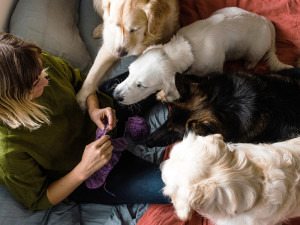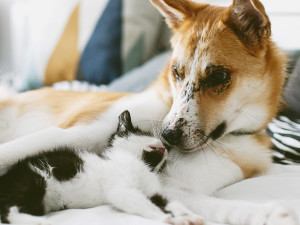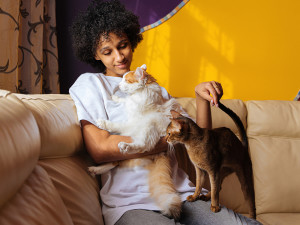Does Your Dog Have Littermate Syndrome?
If you adopted puppy siblings — and they fight nonstop — you could be dealing with littermate syndrome. Here’s everything you need to know.

share article
As a dog trainer, I field a lot of questions about “littermate syndrome.” This email described a familiar scenario: “We were planning to adopt one puppy, but the breeder said that raising two sisters would be easier. After we brought the girls home at nine weeks, their behavior became increasingly out of control. My husband and I could not get their attention for more than a second or two — it was as if we weren’t even in the same room. And then they started displaying alarming fearfulness of people and other dogs.” I made an appointment for a home visit so I could meet the family and the puppies.
Many factors influence behavior, and not all siblings raised together will exhibit this problem, which is called “littermate syndrome.” In other words, it’s a risk, not a foregone conclusion.
That said, many dog behaviorists, trainers, breeders, and shelters actually discourage adopting siblings. Anecdotal evidence suggests that behavioral issues may arise during key development periods because the two puppies’ deep bond impedes their individual ability to absorb and grasp the nuances of human and canine communication. Because fear is the dog’s default reaction to odd or unfamiliar stimuli, this muddled understanding of the world around them can lead to impaired coping mechanisms later on.
Keep reading to learn what is littermate syndrome, exactly, plus how to spot it and prevent it in the first place.
What is littermate syndrome?
Littermate syndrome is a term that describes unwanted behaviors among sibling dogs, including aggression and intense attachment. It is often used to describe behavioral issues that occur when two or more dogs from the same litter are raised together and adopted into the same home.
If you are considering adopting two puppies from the same litter, it is important to do your research and understand the risks of littermate syndrome. By taking steps to prevent it, you can help your puppies develop into well-adjusted and well-behaved dogs.
Signs of littermate syndrome
So, how can you tell if your pups have littermate syndrome? Signs may include:
Fearfulness of unfamiliar people, dogs, and other novel stimuli (aka, neophobia)
Intense anxiety when separated, even briefly
Difficulty learning basic obedience skills
Incessant fighting with each other
Per veterinarian and dog behaviorist Dr. Ian Dunbar: “It’s a disaster waiting to happen for the littermates because they don’t get socialized to other dogs or people, let alone to their owners.” Dr. Dunbar says that any pet parents assume that the dogs’ interactions with one another are adequate, “but when the puppies are five or six months old and meet an unfamiliar dog in a novel setting, they absolutely freak out.”
Dunbar points out that raising littermates requires training two puppiesopens in a new tab, which is particularly challenging when they’re essentially wearing blinders to all but each other. “It’s more than twice the work; it’s exponential. The two combine to produce levels of energy that we can barely measure,” he says. “Tension develops in training and compliance as they squeeze the human out of the relationship. They’re always living with an enormous distraction: each other.”
Certified Applied Animal Behaviorist Patricia B. McConnell, PhD is also against taking in littermates: “They are so busy playing with each other (or squabbling), that you become the odd man out... It seems harder to get their attentionopens in a new tab, harder to teach them emotional control, and harder to teach them boundariesopens in a new tab,” she says. “I have seen some nasty cases of bullying or outright aggression between dogs of the same litter, and it feels as though it is more common than between dogs who come into the family from different litters.”
What are the risks associated with littermate syndrome?
When it comes to the dangers of littermate syndrome, the main one is this: Littermates may become so emotionally dependent on each other that even short separations provoke extreme distress. Behavior specialist and author Nicole Wildeopens in a new tab recalls a case in which two, nine-year-old sibling Huskies attended her group class. “They were so bonded to each other that I literally could not take one and walk a few feet away to practice loose-leash skills because the other would scream.”
Wilde believes the problem is rooted in hyper-attachment, which leads to hindered social development and communication issues: “People assume that having two same-age pups who play together and interact constantly covers their dog-dog socialization needs, but they, in fact, don’t learn how other [dogs] play and have no idea about social skills with other puppies, adolescents, or adult dogs. Perhaps one puppy is a bit of a bully, which their littermate puts up with, but their rude behavior might not be tolerated by a new dog in a new setting.”
During my appointment with the family, we determined that the best course was to rehomeopens in a new tab one of the 12-week-old siblings. Dunbar agrees that it’s often best to separate littermates, especially if symptoms appear early, so that each has a chance to develop normally as an individual. This is obviously a tough decision for the overwhelmed pet parent to make, a sort of canine Sophie’s Choice. Dunbar recommends that potential new owners meet both puppies and determine which to take home.
Can littermate syndrome be prevented?
If you're committed to raising a pair of littermates, you should ensure that the puppies spend significant portions of every day apart so each learns how to be alone — a key lesson in any well-thought-out puppy program. This means feedingopens in a new tab, walkingopens in a new tab, and training each puppy separately, with individual crates in different parts of the home. Even trips to puppy socials and the vet should be separate, so they learn to incorporate these episodes into their respective psyches without being overly dependent on their littermate. (Yes, this can be time-consuming, exhausting, and defeat the original intent of adopting siblings.)
Wilde notes that planned separations must begin immediately. “I’ve been called into homes where four-month-old siblings have been sleeping in the same crate for eight weeks and not purposefully separated by the owners, who had the best intentions but were unaware of littermate issues. Even getting the puppies to sleep in separate crates right next to each other is traumatic for them.”
Dunbar, too, is adamant that one of the key lessons a puppy must master is how to be content with being alone, which is all but impossible with two siblings. “Once we’ve done that, yes, they can live with other dogs and have free run of the house. But if you don’t teach puppies early on how to be alone, and especially with siblings who have always been together, it will be catastrophic when one dies.” Dunbar encourages multiple dog householdsopens in a new tab, but the timing, temperament, and age that each enters the home is paramount.
At the end of the day, the best littermate syndrome prevention might be to avoid adopting siblings in the first place. Most people have never heard of littermate syndrome, finding out about it while researching their dogs’ problematic behaviors. Increasingly, however, trainers and behavior professionals recognize that the cons of adopting siblings far outweigh the pros. “The only advantage I can think of is a short-term gain of the puppies being less lonely in the first month of life,” says Dunbar. “Everything else is a loss.”
Littermate expectations — and hope
While there are indeed struggles in raising siblings — including ongoing dog aggression and fighting often seen between same-sex littermates — there are also well-adjusted cohabitating pairs. A common thread seems to be that littermates are more likely to thrive when introduced into a household with an older dog, who perhaps acts as an arbiter and stabilizing influence.
Myriad factors affect dog behavior, including genetics, early life experiences, and human engagement. As University of California, Davis, veterinary behaviorist Dr. Melissa Bain points out, “Two fearful littermates very well may be genetically predisposed to fear.” Bain is less inclined to apply the term syndrome to the set of symptoms. “It makes you think all littermates have problems, which is not the case.”
She also emphasizes that the level of human involvement is key, saying, “The symptoms escalate when pet parents treat them as one dog with eight legs.” When conflict ensues between the pair, Bain believes it’s because the dogs are similar in size, age, and gender. “This uniformity makes it difficult for the siblings to delineate a hierarchy,” she says.
In the case of the family I was working with, after one of the siblings had been re-homed, the remaining puppy began to thrive under a remedial socialization program. In an email, her human wrote: “Dora has blossomed in the last three months into a delightful household companion, and she continues to improve. She now approaches people out of curiosity. We know she would still be fearful had we not separated the two before it got any worse. Dora has become more confident with all kinds of dogs, and successfully completed a group obedience class.”
Increasing awareness of littermate issues
Recognition of the risks of dual adoption appears to be spreading, with many shelters declining to place siblings together. Shelley Smith, adoption center manager at Pets Unlimitedopens in a new tab in San Francisco, says her shelter stopped placing siblings together after a particularly disturbing case. “A Dachshund mix named Thelma was returned to the shelter because her sibling repeatedly attacked her; she had multiple injuries by the time the heartbroken family returned her to us. Thankfully, we were able to rehome Thelma, but it’s almost certain the fighting and anxiety could have been avoided had the two littermates not been placed together. We now separate siblings and inform adopters about the rationale for our policy.”
While siblings blessed with extraordinary genes and socialization-forward pet parents may avoid littermate syndrome, the consensus among canine professionals is that it’s not worth the risk. Most would encourage people to adopt a single puppy who suits their lifestyle and to focus on the training and socialization that strengthens the interspecies bond unique to humans and dogs. Once your puppy is a dog, by all means, get a second; the two will be at completely different stages, and the older one may very well emerge as a great life teacher to the younger.
FAQ (People also ask):
1. How can littermate syndrome be managed or resolved?
Littermate syndrome can be managed by separating the pups as much as possible — especially during training, feeding, walking, and even sleeping (individual crates in different parts of the home are a good idea).
2. Is littermate syndrome a myth?
Littermate syndrome is not a myth. While there aren’t scientific studies to support it, there is plenty of anecdotal evidence to show it's a real phenomenon.
3. At what age does littermate syndrome start?
Littermate syndrome starts as soon as you bring two puppies home together when they’re around eight to 10 weeks old.
References
Jeff Stallings, CPDT-KA
Jeff Stallings, CPDT-KA, who lives in Santa Cruz, Calif., owns Better Nature Dog Training and works with clients throughout the San Francisco Bay Area.
Related articles
![Overhead shot of woman knitting a pair of purple socks while her four dogs lay on her for attention]() opens in a new tab
opens in a new tabTips on Managing a Multi-Dog Household
The more, the merrier…except when it’s not.
![Big dog meets little brown puppy for the first time]() opens in a new tab
opens in a new tabGetting a Second Dog?
Use these tips before making the big decision.
![dog and cat snuggling together]() opens in a new tab
opens in a new tabAnimal House: How to Intro a New Dog to Your Other Pets
Without turning your home into a circus.
![Two pet parents walking three dogs]() opens in a new tab
opens in a new tabThe Benefits of Having Multiple Dogs
Beyond more puppy love and snuggle time.
![Curly afro woman stroking her bonded cats on the couch in living room]() opens in a new tab
opens in a new tabShould I Adopt a Bonded Pair?
Some besties are inseparable, and that’s not always a bad thing.
![Muscular white pit bull stands on couch, looking out window to sunny fall day.]() opens in a new tab
opens in a new tabSeparation Anxiety in Dogs
Does your dog freak out when you head for the door? Here’s some advice.











